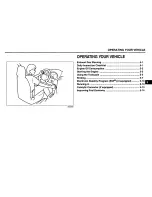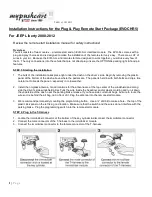
Black plate (24,1)
Cadillac SRX Owner Manual - 2013 - 1st crc - 7/2/12
3-24
Seats and Restraints
When Should an Airbag
Inflate?
Frontal airbags are designed to
inflate in moderate to severe frontal
or near frontal crashes to help
reduce the potential for severe
injuries mainly to the driver's or front
outboard passenger's head and
chest. However, they are only
designed to inflate if the impact
exceeds a predetermined
deployment threshold. Deployment
thresholds are used to predict how
severe a crash is likely to be in time
for the airbags to inflate and help
restrain the occupants.
Whether the frontal airbags will or
should inflate is not based primarily
on how fast the vehicle is traveling.
It depends on what is hit, the
direction of the impact, and how
quickly the vehicle slows down.
Frontal airbags may inflate at
different crash speeds depending on
whether the vehicle hits an object
straight on or at an angle, and
whether the object is fixed or
moving, rigid or deformable, narrow
or wide.
Thresholds can also vary with
specific vehicle design.
Frontal airbags are not intended to
inflate during vehicle rollovers, rear
impacts, or in many side impacts.
In addition, the vehicle has
dual-stage frontal airbags.
Dual-stage airbags adjust the
restraint according to crash severity.
The vehicle has electronic frontal
sensors, that help the sensing
system distinguish between a
moderate frontal impact and a more
severe frontal impact. For moderate
frontal impacts, dual-stage airbags
inflate at a level less than full
deployment. For more severe frontal
impacts, full deployment occurs.
The vehicle has seat-mounted side
impact and roof-rail airbags. See
Airbag System on page 3
‑
20
.
Seat-mounted side impact and
roof-rail airbags are intended to
inflate in moderate to severe side
crashes depending on the location
of the impact. In addition, these
roof-rail airbags are intended to
inflate during a rollover or in a
severe frontal impact. Seat-mounted
side impact and roof-rail airbags will
inflate if the crash severity is above
the system's designed threshold
level. The threshold level can vary
with specific vehicle design.
Seat-mounted side impact airbags
are not intended to inflate in frontal
impacts, near frontal impacts,
rollovers, or rear impacts. Roof-rail
airbags are not intended to inflate in
rear impacts. A seat-mounted side
impact airbag is intended to deploy
on the side of the vehicle that is
struck. Both roof-rail airbags will
deploy when either side of the
vehicle is struck, or if the sensing
system predicts that the vehicle is
about to roll over, or in a severe
frontal impact.
In any particular crash, no one can
say whether an airbag should have
inflated simply because of the
vehicle damage or repair costs.
Summary of Contents for 2011 SRX CROSSOVER
Page 6: ...Black plate 6 1 Cadillac SRX Owner Manual 2013 1st crc 7 2 12 vi Introduction 2 NOTES ...
Page 8: ...Black plate 2 1 Cadillac SRX Owner Manual 2013 1st crc 7 2 12 1 2 In Brief Instrument Panel ...
Page 30: ...Black plate 24 1 Cadillac SRX Owner Manual 2013 1st crc 7 2 12 1 24 In Brief 2 NOTES ...
Page 122: ...Black plate 12 1 Cadillac SRX Owner Manual 2013 1st crc 7 2 12 4 12 Storage 2 NOTES ...
Page 180: ...Black plate 2 1 Cadillac SRX Owner Manual 2013 1st crc 7 2 12 7 2 Infotainment System 2 NOTES ...
Page 356: ...Black plate 6 1 Cadillac SRX Owner Manual 2013 1st crc 7 2 12 11 6 Service and Maintenance ...
Page 358: ...Black plate 8 1 Cadillac SRX Owner Manual 2013 1st crc 7 2 12 11 8 Service and Maintenance ...
Page 372: ...Black plate 4 1 Cadillac SRX Owner Manual 2013 1st crc 7 2 12 12 4 Technical Data 2 NOTES ...
Page 416: ...Black plate 14 1 Cadillac SRX Owner Manual 2013 1st crc 7 2 12 i 14 INDEX 2 NOTES ...
















































